Wastewater dashboard to help keep track of COVID
The Wisconsin Department of Health Services (DHS) has launched an online dashboard, that displays findings from the wastewater surveillance program of the SARSCoV- 2 virus in Wisconsin. SARS-CoV-2 is the virus that causes COVID-19 and is found in the feces of infected people.
Sewage testing has been used for early detection of other infectious diseases and this surveillance system will make it possible to better understand COVID-19 transmission in Wisconsin.
“Surveillance of wastewater is part of our broader statewide efforts to better understand and monitor this virus,” said DHS secretary-designee Andrea Palm. “This publicly available dashboard will also empower both Wisconsinites and leaders, to make more informed decisions about COVID-19 in their communities.”
The new dashboard contains sewershed locations and boundaries, the levels of SARS-CoV-2 virus in the wastewater and the daily new COVID-19 case rates within the chosen sewershed.
A sewershed is an area of land where raw sewage from homes, businesses and industries flows through a series of sewer pipes to a single downstream point, where it enters a wastewater treatment plant. Approximately 70 sewersheds are currently enrolled in this program, which covers over 50 percent of the state’s residents.
Over time, wastewater data can show whether levels of SARS-CoV-2 are rising within a sewershed. This change can be observed as early as a week before there is any rise in cases from clinical testing. Wastewater information can be used together with community COVID-19 case dashboard and other COVID-19-related data, to further inform decisions in responding to the pandemic.
This data will provide public health officials with an opportunity to identify changes in COVID-19 transmission, circulation within a community and potentially, early warning detection of outbreaks.
“This wastewater surveillance data can provide a larger window for public health officials to execute targeted public health interventions,” said Dr. Jonathan Meiman, chief medical officer for the DHS Bureau of Environmental and Occupational Health. “Along with testing, robust contact tracing and monitoring disease activity, this new dashboard will be an important tool in preventing the spread of COVID-19 in communities throughout the state.”
Wastewater monitoring began in June 2020 and will run through June of 2021. The DHS will continue adding sewersheds to the dashboard as more complete data becomes available.



